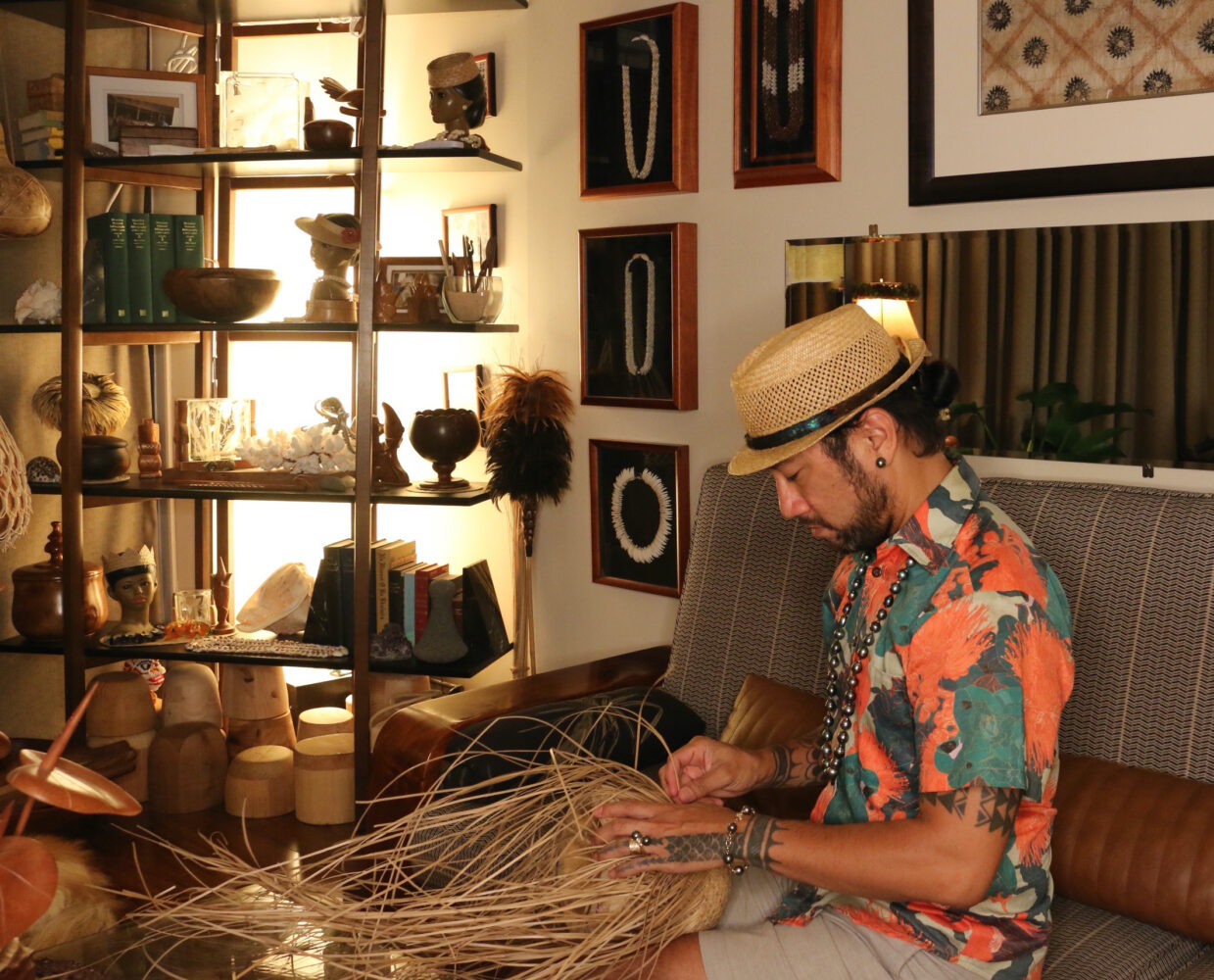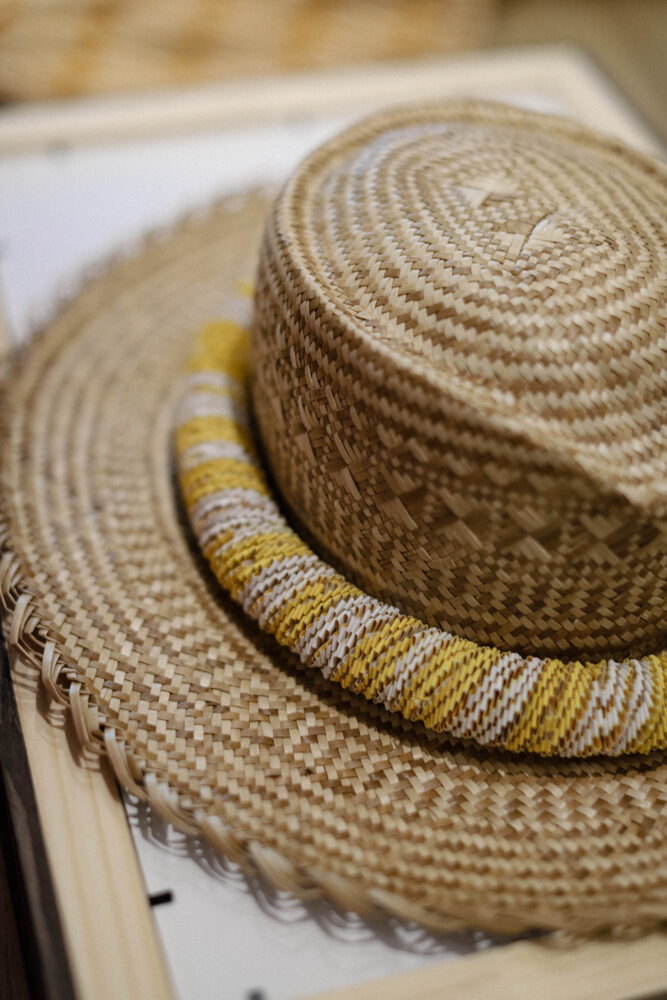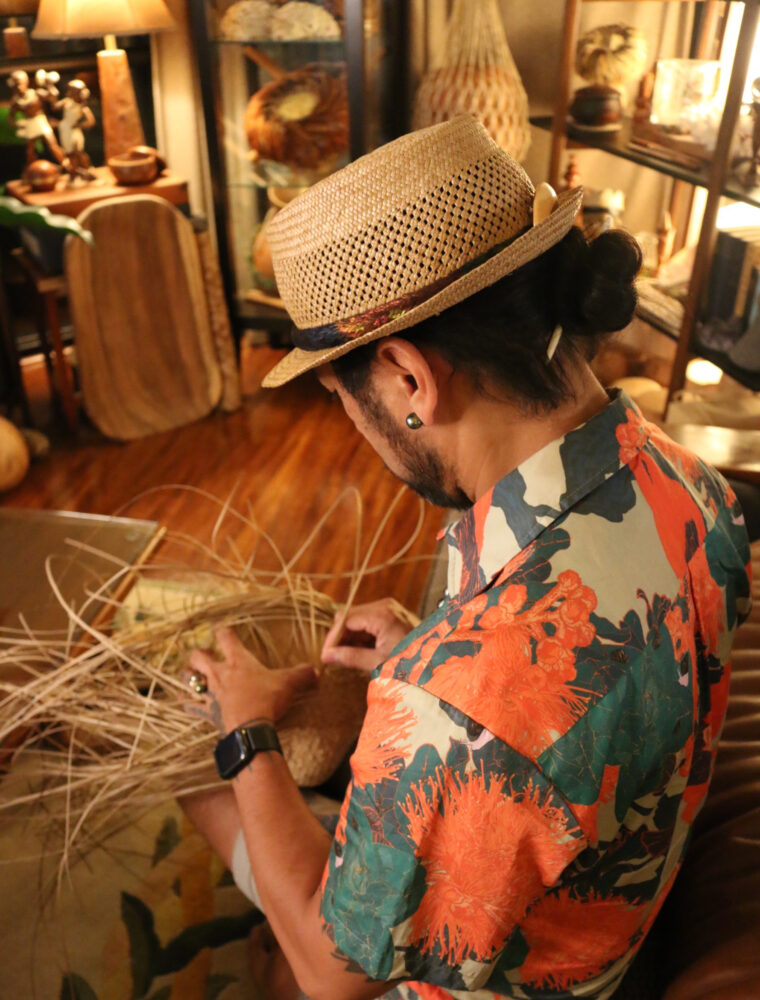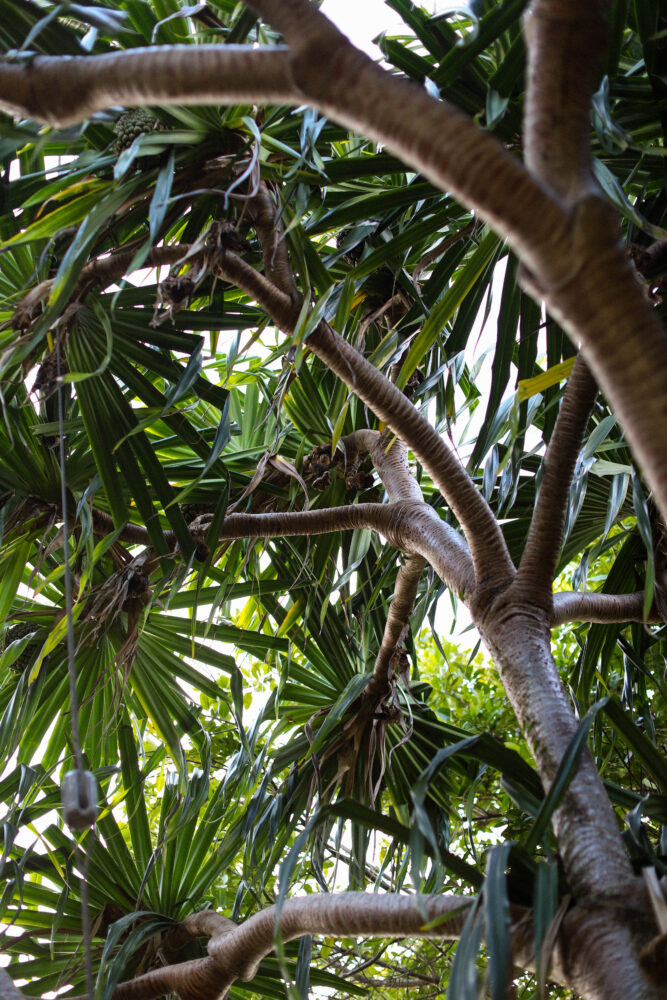

E heluhelu ma ka ʻōlelo Hawaiʻi (Read in Hawaiian).
Weaver Kā‘eo Izon guides weaving groups Hui ʻAla Hīnano & Hui Waianuhea o Ka Pua Hala to strengthen their skills in the art of ulana lau hala and their understanding of the Hawaiian culture and language.
Images by Michael Vossen
Edited by N. Haʻalilio Solomon
The leaves of the hala tree are gathered and neatly woven by skilled hands to become finished and solid pieces to be used such as mats, fans, hats and more. It all depends on the knowledge and skills of the weaver. There are lots of groups that are contributing to the perpetuation of this art — lau hala weaving — and here are two of those groups. Hui ʻAla Hīnano was established in 2019 under the leadership and instruction of the head and teacher, Kāʻeo Izon, along with the supervision and support of the caretaker, Pueo Pata. This is a lau hala weaving group for men. Hui Waianuhea o Ka Pua Hala was later established for women in 2022. Within these two groups, weavers, the “children of Ohiohikupua and Lauhuki,” are nurtured and guided through their journey in learning lau hala weaving while also preserving the Hawaiian culture and language.
Izon got involved with weaving around 2010 while he was living with one of his teachers, Ipolani Vaughan. While at her house, he saw all the beautiful things that she had wove with lau hala. He asked if she could weave something for him, but he was turned down and she responded, “If that’s what you want, you can weave one for yourself.” He did just that until a problem came up while he was weaving. They took his piece to Vaughan’s teacher, Gladys Grace, who saw what he was working on and said, “Your hands are good. You should continue weaving.” Izon then went on to learn from Ipolani Vaughan, Evva Lim, Suzi Swartman, and Margaret Lovett.


As for Pata, when he was a teenager and a student in Nona Mahilani Kaluhiokalani’s hālau hula, the students were tasked with making many different handmade items to be sold during Christmas. That was how he first got involved with lau hala weaving, and so Nona and the elders of her hālau were his first weaving teachers. At that time, however, he didn’t even slightly enjoy it. But that changed in 2016 when he was encouraged by others to weave a fan. To his surprise, it was easy and his hands weren’t unskilled like before. A year later, Pata asked Izon to teach him how to weave with smaller, skinnier strips, and now he has a great love for the art of weaving. He then went on to become Izon’s first student.
Presented below is our interview with Izon and Pata about the two weaving groups, Hui ʻAla Hīnano and Hui Waianuhea o ka Pua Hala.


Kawohikūkahi Adversalo Hello, Kā’eo and Pueo. Could you please explain how Hui ʻAla Hīnano was started?
Kāʻeo Izon The group was established because one of my friends asked me to teach his son. He was 11 years old at the time and I’ve never taught children before, so I was kind of hesitant. His son came by and I was amazed by his dedication and enthusiasm.
KA I understand that your teaching style is different from others. Could you explain the style of learning that the students experience in your groups?
KI One example is when a pattern or a piko is being taught and the student gets confused, I don’t just give them the answer. Instead, I raise questions to get them thinking and on the right track, then we’ll discuss until they understand how to weave it. Once it’s understood, then they’ll be the one to explain it to another student, and that’s how they can fully cement the concept within their understanding.
Pueo Pata The Hawaiian saying, “The mouth stays shut, the eyes watch, the hands work” is important within the two groups. However, Kāʻeo isn’t one to keep us from asking questions. In fact, he actually encourages them. Another thing about his teaching style, if one does something wrong or it doesn’t come out exactly right, Kāʻeo will let us know that it’s wrong and encourage us to undo it and try again. Once it’s good, he’ll say, “Yes, yes, that’s it.” And another thing is that we watch him a lot while he’s weaving as an example of how the weaving should be done.
People really love all the different things that are woven out of lau hala. However, one problem with people nowadays is that they don’t know how much work goes into lau hala weaving. They only see the end result of the woven piece.
Kā‘eo Izon, kumu


KA Students within the group are taught about the story of the hala and there’s also some pule created by Pueo. Could you explain the importance of these and how they serve as tools for the students in furthering their understanding and connection with ulana lau hala?
PP As for the legend of Ohiohikupua that was obtained by Fornander, it’s a repository of knowledge for everything about that hala tree, preparing the leaves, and other important and valuable information. As for the chants that I’ve created, I included the appropriate practices of both Hui ʻAla Hīnano and Hui Waianuhea o ka Pua Hala, as well as the genealogy of Kāʻeo’s kumu and weaving knowledge. When these chants are recited, the things of the past are then connected with us here in the present. Another thing is that there are many cultures around the world that weave lau hala or other materials. However, for us Hawaiians, it’s the customs, the words we use, the knowledge passed down, the legends, the movement of one’s hands that is learned by the student from their teacher — those are the things that make our weaving Hawaiian. And so, that also became another thing that I had included within my chants.




KA Within the groups, the responsibility of teaching and helping all the students isn’t just placed on the teacher. Instead, the students are encouraged to help each other, and through those relationships, they become close just like a family. Why is this such an important aspect of the group and how does this help the students in their understanding of the art?
KI The amount of students in the two groups grew a lot, so I’m not able to help everyone on the one day that’s set aside for teaching them. Therefore, helping and supporting one another is convenient and advantageous so that they can fully grasp what they have learned.
PP The two groups are built on relationships and the idea of “loving and caring for one another.” And as for our dependence on each other, we find that there’s power in that. It’s also a good example for how we should act and behave when weaving and even amongst everyday life.
For us Hawaiians, it’s the customs, the words we use, the knowledge passed down, the legends, the movement of one’s hands that is learned by the student from their teacher — those are the things that make our weaving Hawaiian.
Pueo Pata, kahu
KA Kāʻeo, you’re also very popular on TikTok and Instagram. In regards to the things that you post on these platforms, is there anything specific that you hope the public gets from it?
KI People really love all the different things that are woven out of lau hala. However, one problem with people nowadays is that they don’t know how much work goes into lau hala weaving. They only see the end result of the woven piece. When they see the price, some grumble, “It’s just leaves. The price isn’t reasonable. It’s expensive.” This is definitely true. It’s just leaves. But how’s the weaver’s hands? Are they skillful or unskilled? Or are they unskilled and novice? That’s what’s really important. That’s the reason why I post videos on TikTok and Instagram, so that the public can see with their own eyes the amount of work that weavers put into the art, and so they can better appreciate this skillful art.




KA What are your hopes for the future of the students, the art of ulana lau hala, and the culture and teachings that have been nurtured within the group?
KI That they excel and their skills surpass mine, that they continue to progress, and that they continue to perpetuate and preserve what they’ve learned.
PP That the students continue with the generosity and kindness that has been extended to us by Kāʻeo and now inherited by us as parts of our characters. And that they’ll also continue to love and care for each other without deviating from the path of what’s proper.
This story is part of Flux Hawaii’s Hawaiian-language reporting series featuring articles produced all in ‘ōlelo Hawai‘i. This series, in partnership with Kīnā‘ole Foundation, features the next generation of Native Hawaiians carrying on their ancestral traditions and returning aloha to the world.

